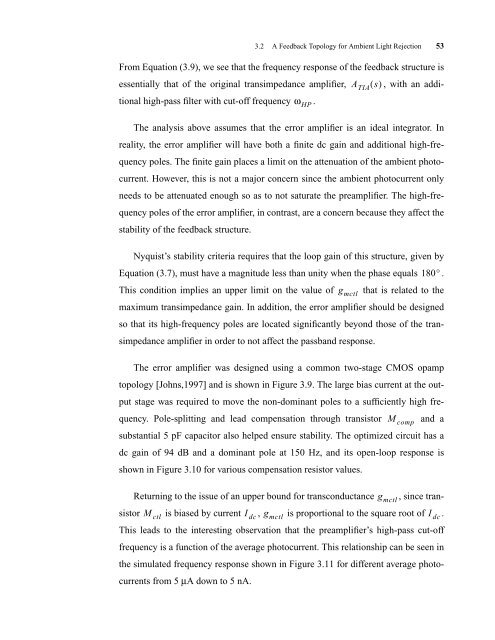CMOS Optical Preamplifier Design Using Graphical Circuit Analysis
CMOS Optical Preamplifier Design Using Graphical Circuit Analysis
CMOS Optical Preamplifier Design Using Graphical Circuit Analysis
You also want an ePaper? Increase the reach of your titles
YUMPU automatically turns print PDFs into web optimized ePapers that Google loves.
3.2 A Feedback Topology for Ambient Light Rejection 53<br />
From Equation (3.9), we see that the frequency response of the feedback structure is<br />
essentially that of the original transimpedance amplifier, ATIA( s)<br />
, with an addi-<br />
tional high-pass filter with cut-off frequency ωHP .<br />
The analysis above assumes that the error amplifier is an ideal integrator. In<br />
reality, the error amplifier will have both a finite dc gain and additional high-fre-<br />
quency poles. The finite gain places a limit on the attenuation of the ambient photo-<br />
current. However, this is not a major concern since the ambient photocurrent only<br />
needs to be attenuated enough so as to not saturate the preamplifier. The high-fre-<br />
quency poles of the error amplifier, in contrast, are a concern because they affect the<br />
stability of the feedback structure.<br />
Nyquist’s stability criteria requires that the loop gain of this structure, given by<br />
Equation (3.7), must have a magnitude less than unity when the phase equals 180° .<br />
This condition implies an upper limit on the value of that is related to the<br />
maximum transimpedance gain. In addition, the error amplifier should be designed<br />
so that its high-frequency poles are located significantly beyond those of the tran-<br />
simpedance amplifier in order to not affect the passband response.<br />
The error amplifier was designed using a common two-stage <strong>CMOS</strong> opamp<br />
topology [Johns,1997] and is shown in Figure 3.9. The large bias current at the out-<br />
put stage was required to move the non-dominant poles to a sufficiently high fre-<br />
quency. Pole-splitting and lead compensation through transistor and a<br />
substantial 5 pF capacitor also helped ensure stability. The optimized circuit has a<br />
dc gain of 94 dB and a dominant pole at 150 Hz, and its open-loop response is<br />
shown in Figure 3.10 for various compensation resistor values.<br />
Returning to the issue of an upper bound for transconductance , since tran-<br />
sistor M ctl is biased by current I dc, gmctl is proportional to the square root of I dc.<br />
This leads to the interesting observation that the preamplifier’s high-pass cut-off<br />
frequency is a function of the average photocurrent. This relationship can be seen in<br />
the simulated frequency response shown in Figure 3.11 for different average photo-<br />
currents from 5 µA down to 5 nA.<br />
g mctl<br />
g mctl<br />
M comp














